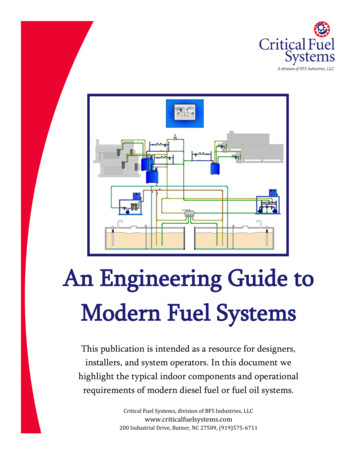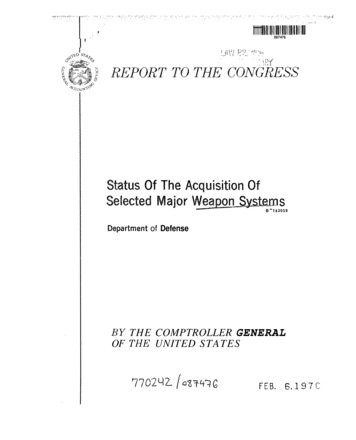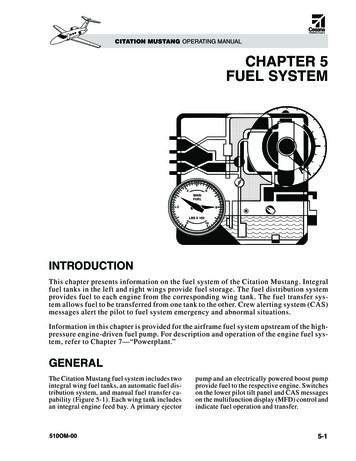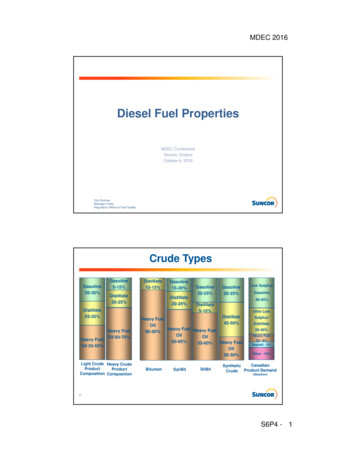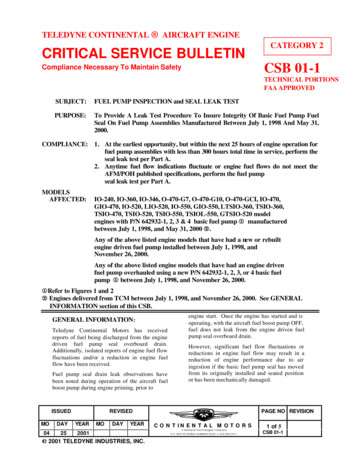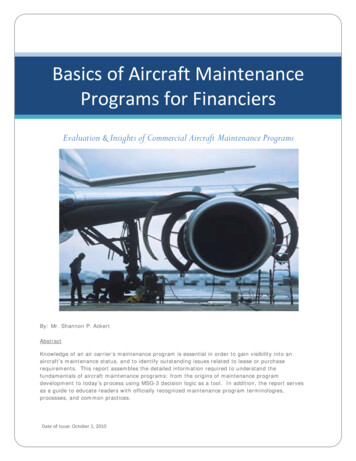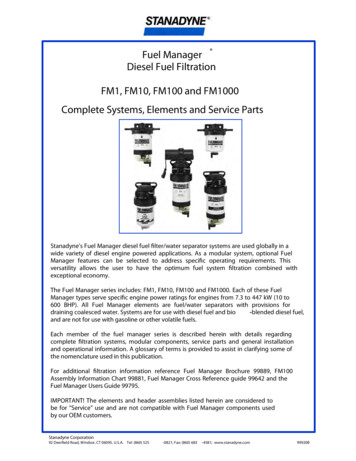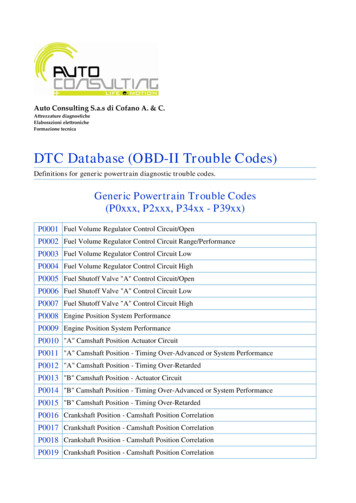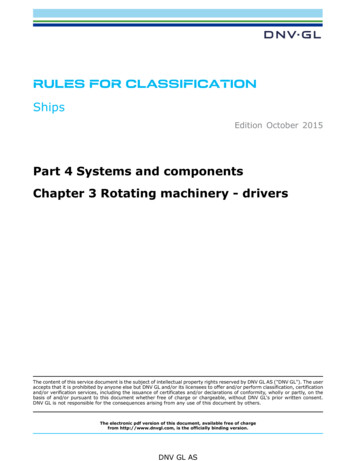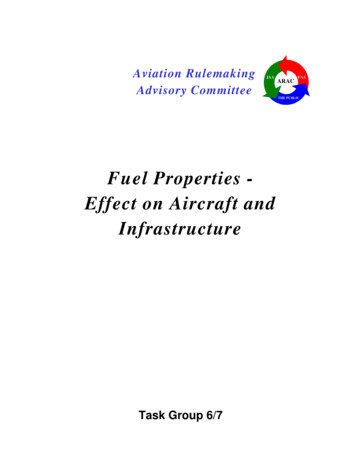
Transcription
Aviation RulemakingAdvisory CommitteeJAAFuel Properties Effect on Aircraft andInfrastructureTask Group 6/7ARACFAATHE PUBLIC
FINAL REPORT—Revised 7/15/98aTask Group 6/7 on Fuel PropertiesReport to the Fuel Tank Harmonization Working Group of theFAA Aviation Rulemaking Advisory Committee1.0 ABSTRACTThe Fuels Properties Task Group was charged with assessing the feasibility of using jetfuel with a higher flash point in the civil transport airplane fleet than required by currentJet A/Jet A-1 Specification, as a means of reducing the exposure of the fleet toflammable/explosive tank vapors. This report describes the efforts performed by TaskGroup 6/7 for the Aviation Rulemaking Advisory Committee (ARAC) Fuel TankHarmonization Working Group.Raising the minimum flash point of jet fuel will result in a combination of changes toother fuel properties, such as viscosity. The magnitude of change is dependent on theseverity of flash point increase. The engine and APU manufacturers have no experiencebase for such modified fuels, and are concerned about the risk of adverse impact onaltitude relight and low temperature operations (especially Extended Twin Operations,ETOPS). Mitigating actions, including hardware modifications, fuel specificationrevisions, use of additives and revised operational limits, have also been reviewed.Dependent on magnitude of change, laboratory, rig and/or full-scale engine testing onreference fuels may be required to quantify the impacts.Raising the minimum flash point could also significantly raise the manufacturing cost anddecrease the availability of the modified jet fuel. The predicted impact on jet fuel pricecould be significant. Again, the higher the flash point, the more severe the affect.The fuel impacts are most severe outside of the U.S. because of the differences inoverseas refinery configurations and product demand. Some countries indicated thatchanges in flash point are not viable options to which they would subscribe (Canada,United Kingdom, New Zealand, Australia, Japan, Russia and the Commonwealth ofIndependent States).
Report of Task Group 6/7 on Fuel Properties2.0 SUMMARYThe Fuels Properties Task Group (Task Group 6/7) was formed by the FAA-ARAC FuelTank Harmonization Working Group to assess the impacts of raising the minimum flashpoint, and possibly lowering the freeze point, of commercial Jet-A/A-1 aviation fuel.Task Group 6/7 was comprised of representatives from the engine powerplant andauxiliary power unit (APU) manufacturers, petroleum industry, airframe manufacturers,air carriers, and the Department of Defense. The impacts on Engines, APU's, hardwaremanufacturers, jet fuel availability and cost are based on evidence and information drawnfrom surveys conducted of refiners in the U.S. (by API/NPRA), Europe (by Europia), andJapan (by PAJ), as well as responses from other international refiners.The findings of the Task Group are summarized below:2.1 Impact on Engine Integrity, Operation and MaintenanceThe predicted fuel changes identified will result in a combination of fuel properties thatcan fall outside the current experience base. The magnitude of property change andpotential introduction of new molecules increases with increasing flash point. Evaluationof such changes identifies the following key issues: Increases in low temperature viscosity and decreases in volatility are fuel propertychanges that may adversely impact operation /safety including failure of engine/APUcold starts and high altitude relight (including cold soak relight). Reduced fuel pump life due to increased wear rate when operating on lower lubricityfuels which may result in component failure. The following increased maintenance cost effects were identified but not quantified: Increased maintenance of combustion and turbine components due to poorercombustion quality. Fuel system and injector nozzle cleaning at more frequent intervals due tofuel lacquering and coking. Reduced fuel pump life due to increased wear rate. Depending on the magnitude of the flash point increase, laboratory rig or full enginetesting on representative high flash point reference fuels may be required to fullyevaluate/quantify these effects. Emissions testing to verify EPA / ICAO regulatory requirements becomesincreasingly probable with magnitude of flash point change. Mitigating actions were examined. They may include: hardware modifications, fuelspecification revisions, and revised aircraft operational limits. The use of newadditives will require extensive evaluation and approval programs.2
Report of Task Group 6/7 on Fuel Properties Any change to the minimum flash point will also necessitate the installation of heatedauxiliary power units at an estimated cost of 1 million per APU model. The magnitude of the flash point change will dictate the actions required and costincurred to continue to meet civil airworthiness requirements.2.2 Impact on Jet Fuel Properties An increase in the jet fuel flash point specification will result in shifts of fuelproperties. At some increase in the flash point specification, a high flash Jet-Abecomes a new fuel, never before produced or used, with properties unlike any otherfuel. For example, the viscosity is expected to be significantly higher than JP-5. The uncertainty concerning jet fuel properties resulting from a large flash pointspecification increase is a significant concern. The engine manufacturers have noexperience base for such modified fuels. As the minimum flash point is increased, the average flash point of the jet fuel pool ispredicted to be 12-15 F (6-8 C) above the flash point specification in the U.S. due topipeline specifications and test method precision The shifts in jet fuel properties are expected to occur by three mechanisms:1. By changes in the distillation cut points of conventional refining.2. By creating incentives for jet fuel to be produced by modified processingschemes.3. By causing localities relying on unique refinery configurations or crude sources toexperience “magnified” shifts in jet fuel properties.2.2.1 Changes in Distillation Cut Points of Conventional Refining The impact of mechanism 1 was quantified by the Jet Fuel Properties Survey. Theresults found potentially important adverse impacts on: 10% Boiling PointViscosityAromatics ContentSmoke PointDensityJet Fuel Availability Jet fuel distillation yield is reduced by more than 1% per F flash pointincrease. Many of the crude oils examined cannot produce Jet A-1 with a very highflash point.3
Report of Task Group 6/7 on Fuel Properties Extrapolations in the growth of jet fuel consumption indicate pressure alreadyexists on jet fuel availability and properties. The yield loss associated with anincreased flash point specification exacerbates this situation.2.2.2 Creating Incentives to Produce Jet Fuel by Modified Processing The yield loss associated with an increased flash point specification can createincentives for jet fuel to be produced by modified processing schemes. The impactcould not be quantified on the short time scale of this study but the use ofunconventional refinery processing is a significant concern: Larger flash point changes result in greater incentives for the use of modifiedprocessing schemes. One example of an unconventional processing scheme results in the increased useof hydrotreated cracked stocks in jet fuel. This could push certain propertiestowards the specification limits resulting in adverse impacts on: Aromatics Content Smoke Point Thermal Stability The production of jet fuel by a different mix of conventional processing schemesshould not impact fuel properties as much as the use of unconventionalprocessing. However, the increased use of severe hydrotreating (a conventionalprocess) is expected to negatively impact fuel lubricity.2.2.3 Magnified Shifts in Localities with Unique Refinery Configurations or CrudeSources Localities relying on unique refinery configurations or crude sources may experience“magnified” shifts in jet fuel properties. Although this could not be quantified in theshort time frame of this report, the following examples illustrate this concern: Areas using predominately naphthenic crude oils (such as those found inCalifornia) might experience viscosity shifts much larger than average resulting ina significant number of batches being produced close to the specification limit. The increased use of severe hydroprocessing, to restore fuel availability, may causesome localities to receive mostly low lubricity fuel. Some fuel properties may be addressed by the use of additives.4
Report of Task Group 6/7 on Fuel Properties2.3 Impact on Jet Fuel Availability and Manufacturing Cost The higher the flash point the more severe the impact. Higher flash points could result in significant shortfalls of jet fuel availability andcould require at least five years for industry to endeavor to meet jet fuel demand. In the U.S., average refinery shortfalls of about 5% at 120 degrees and about 20% at150 degrees could occur (weighted average, assuming 1 - 2 years lead time Outside the United States, requirements for higher flash point jet fuels could result inproduction shortfalls of 12% at 120 degrees and up to 49% at 150 degrees (weightedaverage, assuming 1 - 2 year lead time). The API survey results address jet fuel demand at 1998 levels. The survey does notaddress long-term changes in jet fuel demand, which is projected to grow by 6 - 15%more than other refined products by 2010. Environmentally driven reformulation ofother fuels, (e.g., toward “light” diesel) will further increase demand for the jet fuelportion of the barrel. These pressures are likely to amplify the difficulties predictedfor the 1998 level. Requirements for higher flash point jet fuels could result in United States refineryproduction cost increases of 1.5-2.2 cents per gallon at 120 degrees and 6-7.5 centsper gallon at 150 degrees (assuming 7% ROI). Based on current U.S. jet demand,this translates into annual costs of 350-520 million at 120 degrees and 1.4-1.7billion at 150 degrees. Outside the United States, requirements for higher flash point jet fuel will result inrefinery production cost increases of 3-15 cents per gallon at 120 degrees and morethat 20 cents per gallon at 150 degrees. Based on current jet demand, this translatesinto annual costs of 320-900 million for the 120 to 150 range of flash points(assuming 15% ROI). The potential for increased production cost and decreased capacity could dramaticallyimpact the market price of jet fuel. Price elasticity models have been used tocalculate the increases in price that could occur for various combinations of capacityreductions and price elasticities. Based on a price elasticity of 0.2, the annual cost is 4 to 13 billion. No substitutions for jet fuel were assumed to be available.2.3.1 Impact Outside the United States The difference between U. S. and non-U.S. availability and cost result from: The lower yields associated with the manufacture of lower freezing point JetA-1, which is the predominant jet fuel outside the U.S. Markedly different regional petroleum product demand and refinery structure.5
Report of Task Group 6/7 on Fuel Properties Based on the surveys, more refiners worldwide than in the U.S. reported that it is notfeasible to produce higher flash point jet fuels in the current refinery installations. The Task Group attempted to determine the potential for localized supply anddemand imbalances due to increased flash point requirements. Results of informalsurveys showed that individual refineries vary greatly in their flexibility to providethe same fuel volume at various flash points, but it was not generally possible topinpoint specific airport supply imbalances in the U.S. Australia, New Zealand, andJapan were identified as subject to potential shortages of Jet A-1 fuel if flash pointrequirements are increased.2.4 Other Issues As the minimum flash point increase, more refiners are likely to have difficultyproducing gasoline and diesel that complies with current state and federalenvironmental regulations. Engine emissions may need to be remeasured for reporting purposes, and somenumber of engine models may been to be recertified. Commercial airlines will continue to uplift low flash fuels particularly in Russia andthe Commonwealth of Independent States (C.I.S.) and Wide-Cut fuels in NorthernCanada. In today's global market, there is no practical way to avoid mixing fuelsfrom different parts of the world. Cold climate operation could become an issue at higher minimum flash points.Increasing the flash point would reduce the more volatile, low-boiling components ofthe fuel, which in turn leads to an increase in viscosity and exacerbates an alreadytenuous cold starting situation and APU in-flight starting problems. Russian aircraft and engines have not been designed to operate on high flash fuel.Impacts on their operability and airworthiness have not been determined.The aviation fuel community has a high confidence level with currently produced fuelbecause of a long experience base. Task Group 6/7 cannot readily measure the existingmargin to alter the fuel for all aircraft engine types. Effects from changes at a single sourceare difficult to determine because they are usually lost in the pool fuel volume, so thatcontinuous operation at the extremes of the property limits is infrequent. Conversely,changes to the jet fuel pool as a whole, must of necessity, be viewed with concern. Theconcern for a change in minimum flash point to 110-120ºF is significant; for a change to140ºF it is many times higher because refiners can be expected to change productionmethods and reduce specification margins on a broad scale. Possible mitigating actions tooffset adverse effects on engine and APU operation might include hardware modifications,adjustments and re-calibrations. Other revisions of fuel specification requirements may benecessary in addition to the flash point increase the impact of such additional changes onavailability has not been evaluated.6
Report of Task Group 6/7 on Fuel Properties3.0 TABLE OF CONTENTS1ABSTRACT223344556SUMMARYImpact on Engine Integrity, Operation and MaintenanceImpact on Jet Fuel PropertiesChanges in Distillation Cut Points of Conventional RefiningCreating Incentives to Produce Jet Fuel by Modified ProcessingMagnified Shifts in Localities with Unique RefineryConfigurations or Crude SourcesImpact on Jet Fuel Availability and Manufacturing CostImpact Outside the U.S.Other Issues7TABLE OF 18191919191919202021222324BACKGROUNDThe Development of SpecificationsThe Manufacture of Jet FuelConventional ProcessesThe Crude UnitJet Fuel Hydrotreating/HydrodesulfurizationMerox ProcessHigh Pressure Hydrotreating/HydrocrackingCatalytic Cracking/Thermal CrackingRefinery Configuration IssuesAdvanced Processes for Jet Fuel ProductionAromatics Saturation of Cracked or Aromatic StreamsJet Fuel Synthesis by Fischer-Tropsch ChemistryExperimental Processes for Jet Fuel ProductionCatalytic DewaxingJet Fuel Synthesis by AlkylationTransportation from Refinery Gate to AirportAircraft Fuel System DesignCurrent Jet Fuel DemandDemand for Other DistilatesMilitary Experiences27DESIGN ALTERNATIVES7
Report of Task Group 6/7 on Fuel Properties282828INSTALLATION/RETROFIT REQUIREMENTSFuel Phase-in RequirementsRetrofit L DATAFlash PointTank Ullage FlammabilityFlash Point Methods and SignificanceFlash Point DistributionsUnited States DataU.K. Defense Research Agency Flash Point DataEuropean Flash Point DistributionAverage Flash Point Distribution Curve WorldwideFlash Point MarginsFlash Point PredictionsFuel Property EffectsFuel Property Effect PredictionsIntroductionThe Impact of Modified Distillation Properties: Jet FuelProperties SurveyThe Impact of Modified Jet Fuel RefiningLocal ImpactsThe Impact of Uncertainties in Fuel PropertiesFuel Property Effects on AirframesMaterial CompatibilityHeat Content and DensityFreezing PointViscosityFuel Property Effects on Engines & Auxiliary Power UnitsGeneralFlash Point and DistillationViscosityAromatics and Smoke PointSulfur ContentThermal StabilityFreeze Point (Cold Flow Properties)Lubricity (Lubricating Qualities)Heat of Combustion and DensityAPU Operational ImpactsGround Infrastructure & FungibilityEnvironmental EffectsAircraft EmissionsJet Fuel Manufacturing EmissionsEvaporative EmissionsAdditives in High Flash Jet 95959606161626364648
Report of Task Group 6/7 on Fuel Properties656565666666Metal Deactivator AdditiveStatic Dissipator AdditiveCorrosion Inhibitor/Lubricity AdditivesFuel System Icing Inhibitor (Anti-icing additive)Miscellaneous AdditivesResearch Opportunities for Additives68AIRWORTHINESS REQUIREMENTS6969696969707070SAFETYOperation on Low/High Flash FuelsOperation in Cold ClimatesCanadaScandinavia and the Baltic StatesRussia and the C.I.S.Russian and C.I.S. Aircraft Operation on High Flash Fuel.Changing the Experience Database737474747575757575767778808183COST AND AVAILABILITY IMPACT OF HIGH FLASH JET FUELFuel Cost EstimatesUnited StatesEuropeRest of the WorldAvailability of FuelUnited StatesEuropeRest of the WorldFuture Projection of Jet Fuel DemandLocal SituationsImpact of Availability on PricingEffects on Crude Oil SelectionEffect on RefiningEffect on APU Cost84App. 1App. 2App. 3App. 4App. 5APPENDIXESFinal Report API/NPRA Aviation Fuel Properties SurveyEUROPIA Effect of Jet A-1 Flash Point on Product Availability andPropertiesPAJ Impacts of Jet A-1 Flash Point ChangesFuel Property Effects on Engines (Section 9.3.2, Table 1)Estimate of Ten-Year Cost of Fuel Change9
Report of Task Group 6/7 on Fuel Properties4.0 INTRODUCTIONThe purpose of this report is to evaluate the availability, cost, and risk associated withchanging to a high flash point jet fuel for commercial aviation.In November 1997, the FAA requested that the American Petroleum Institute (API)examine the ramifications (production, cost, schedule) of the United States commercialaviation industry utilizing a Jet A/A-1 type of fuel with a minimum flash point of140oF(60oC) to 150oF(66oC) in place of the current Jet A/A-1 fuel. The FAA alsorequested that the API participate in a dialogue with FAA and industry technicalspecialists regarding this proposal. In a subsequent letter from the FAA dated February26, 1998 to API, the petroleum industry was asked by the FAA-ARAC Fuel TankHarmonization Working Group to develop and compile data on the availability of a Jet Atype fuel (both domestic and international) with a higher flash and a possible lowerfreezing point. The FAA requested the assessment of possible impact on productionvolumes; short- and long-term cost increments and capital investments to make up anyloss in production. For this assessment, flash points of 120oF(49oC) to 150oF(66oC) inten degree increments were identified, as well as freezing points of -40oF(-40oC) and 53oF(-47oC).The API, in conjunction with the National Petrochemical & Refiners Association(NPRA) conducted a survey of individual refineries to assess the availability and cost ofproducing high flash point fuel for commercial aviation in the U. S., Europe, and otherparts of the world. This report presents the combined results of the API/NPRA survey(Appendix 1), European (EUROPIA) survey (Appendix 2), and the PAJ (PetroleumAssociation of Japan) survey (Appendix 3) and correspondence with some refineries inother parts of the world.The aviation industry representatives assigned to Task Group 6/7 include jet fuelsuppliers who are represented by the API, airlines, engine, auxiliary power unit (APU),and airframe manufacturers as well as government representatives, including the FAA.This Task Group has investigated the complex issues associated with raising the flashpoint and lowering the freezing point of commercial aviation jet fuel. The impacts onaircraft engines, APUs, aircraft systems, fuel transportation, fuel availability, and fuelcost as well as the possible implications on the production of other petroleum productshave been studied. In addition, the Task Group has considered flight safety, certificationissues, emissions, military experience, and the impact on fuel price.10
Report of Task Group 6/7 on Fuel Properties5.0 REFERENCESReferences are included in the individual sections.11
Report of Task Group 6/7 on Fuel Properties6.0 BACKGROUND6.1 The Development of SpecificationsJust as military jet operation preceded commercial flights by more than 10 years, militaryfuel and commercial specifications showed the same time lag. The earliest U. S. AirForce specifications for grades JP-1 and JP-2 never achieved wide usage. Published in1947, grade JP-3 maximized availability by a blend of kerosene and gasoline with thevapor pressure of aviation gasoline. After this wide-cut fuel caused high boiling losses inhigh altitude operations, subsequent changes were directed toward tightening quality,particularly volatility. First the wide-cut JP-4 reduced vapor pressure drastically in 1951;then the kerosene-type JP-8 removed lighter components altogether in 1979. By closelymodeling JP-8 after the commercial Jet A-1 grade the Air Force hoped to maximize itsavailability. These volatility decreases were possible in part because of a continuingdecrease in DOD fuel consumption, but JP-8 caused numerous performance problems,particularly with older equipment. In 1952 the U.S. Navy developed JP-5, a low volatilityfuel, to protect aircraft carrier tankage. Because of the restrictive combination of highflash point and low freezing point and because its use has been primarily restricted tocarrier operations, this fuel has always had limited use and availability.ASTM specifications have included both kerosene and wide-cut grades since 1959, butthe wide-cut grade, Jet B, has seen no use in the U. S. and only limited use outside theU.S. Instead the Jet A grade has represented the best compromise between the propertiesof commercial kerosene and the requirements of aircraft operation within the U.S. Forinternational operations the Jet A-1 grade followed the British lead with a lower freezingpoint. Over the years the compromise between availability and performance has held upwell except for two specification areas where shortages forced relaxations. Due to supplydislocations which required blending with less desirable crudes in 1973 an increase inaromatic content and a decrease in smoke point was permitted, provided the deviationswere reported to the operators. At the same time the freezing point of Jet A-1 was raisedfrom -50 to -47 C, a relaxation which was carried over into other specifications. Todaythe reporting requirements have been dropped and the decreases in combustionrequirements have been made permanent in recognition of satisfactory aircraftperformance. The changes were made only after reviews of equipment performance toassure the absence of unexpected secondary effects.Selected requirements of U. S. military and commercial specifications are summarized inTable 1, attached. Only those properties thought to be influenced by an increase in flashpoint or freezing point have been included. For a later comparison Table 1 also containsthe same requirements of the Russian specification, TS-1.Overall, the current jet fuel specifications are experience based and tend to reflectsolutions to past problems. Specifications, therefore, cannot be expected to anticipate newproblems that might occur with fuels meeting current specifications. An example is thecurrent focus on fuel lubricity difficulties that seem to have increased as refineryprocessing has been changing. Because this property has not caused difficulties in past12
Report of Task Group 6/7 on Fuel Propertiescommercial operations it is not currently limited. However, as this problem has becomemore prominent, efforts are underway to modify specifications to control this property. Inthe case of fuels produced from novel sources or new processes it is necessary to reviewthe performance of such products before deciding on the applicability of existingspecifications.Specification Grade Property Aromatics, vol. %Max.Sulfur, mass %Max.Distillation, C ( F)IBP10% rec.Max.20% rec.50% rec.90% rec.98% rec.Final BPMax.Flash point, C ( F)Min.RVP, kPa (psi)ASTM D1655Jet A/A-1Joint Check ListJet A-1MIL-T-5624JP-5MIL-T-5624JP-4GOST 10227TS-1250.322 a0.3025.00.4025.00.40220.25Report206 (403)ReportReportReportReportReport100 max.125 max.Report150 Max.ReportReportReport205 (400)ReportReportReport300 (575)38* (100)300 (575)40* (104)300 (575)60** (140)270Density, kg/m3Freezing point, C ( F)Max.Viscosity @-20 C, csSpecific energy, MJ/kgSmoke point, mm orSmoke point , mm Naphthalenes, vol. %JFTOT @ 260 CTube rating775 – 840-40 b (-40)775 – 840-47 (-53)788 - 845-46 (-51)842.825183.08.042.825193.0 3Pressure drop, mm Hg Max.AdditivesAnti-icing, vol. %AntioxidantCorrosion inhibitor/Lubricity agentMetal deactivatorConductivity improverConductivity, pS/mMax.Min.Min.Min.Max.205 (400)195 Max.230 Max.250 Max.28 (82)14 - 21(2.0-3.0)-58 (-72)775 Min.-50 (-58)8.542.61942.820.08 @ -4042.925 3 3 menteAgreement0.15 – 0.20AgreementeRequired0.10 – equiredPermittedNot permittedPermittedRequiredAgreement50 – 450 f50 - 450150 – 60050 – 600fcMax.18 mg/100 mLMax.dAgreementAgreementAgreementSection 6-1, Table 1--Critical Fuel Properties in Specifications13
Report of Task Group 6/7 on Fuel Propertiesaor 25% max report % hydrogenJet A-1 freezing point is -47 C (-53 F) maximum.cASTM D1655 permits retesting at 245 C.dDifferent test method. Correlation with D 3241 (JFTOT) being established.eRequired if hydrotreatedfIf conductivity improver is used* Flash point by D 56 (Tag)** Flash point by D 93 (PM)b6.2 The Manufacture of Jet FuelGenerally in the US, the system to produce and consume petroleum products is wellbalanced. This actually is an operational constraint because there is relatively littlestorage capacity for refined products built into the distribution system. The U.S. refinerysystem is optimized to produce a large amount of motor gasoline and smaller amounts of“No. 2 fuels” (diesel fuel/heating oil) and “No. 1 fuels” (jet fuel, No. 1 diesel fuel andNo. 1 fuel oil).The production of petroleum products is a complex process. Some of the complexity ofthe system is retained in this overview, despite the temptation to simplify, because theimpact of jet fuel specification changes can only be appreciated with some knowledge ofthe complexity of the production system.6.2.1 Conventional Processes6.2.1.1 The Crude UnitPetroleum products originate from crude oil. There is no such thing as a “typical” crudeoil. All crude oils are unique mixes of many different chemical compounds. Animportant variable of crude oils is the yield of light products (gasoline, No. 1 fuels, andNo. 2 fuels) that they can produce when distilled. The demand for a crude oil generallycorrelates with the yield of light products that can be produced from it. Crude oil isprocessed into petroleum products at refineries. Refineries vary greatly in complexity.The simplest refinery consists of only an atmospheric crude distillation unit. Mostrefineries, however, also have a vacuum distillation unit in which case the units, together,are known as the crude unit (Section 6.2, Figure 1.)14
Report of Task Group 6/7 on Fuel PropertiesSection 6.2 Figure 1. Schematic Diagram of a Crude Unit.GasGasolineKeroseneLight VacuumGas OilGas OilCrudeHeavy VacuumGas OilVacuum ResidueAtmospheric DistillationVacuum DistillationThe crude unit separates crude oil into various fractions (or streams) by distillation. Thetypical streams produced from a crude unit are:StreamGasGasolineKeroseneGas OilVacuum Gas OilResidueTypical Boiling Range F C 100 38100 – 40038 – 205300 – 500150 – 260400 – 650205 – 345600 – 1000 315 – 540 1000 540Finished Products or DispositionLiquefied Petroleum GasGasoline/NaphthaJet Fuel, No. 1 Diesel, No. 1 Fuel OilDiesel Fuel, No. 2 Fuel Oil, Heating Oil, Cracker FeedLube, Cracker FeedAsphalt, Coker FeedAccording to the API/NPRA Aviation Fuel Properties Survey (Appendix 1), 78% of thecapacity to make jet fuel in the U.S. is production from crude units.In operating a crude unit there are basically only three parameters that can be adjusted toinfluence the yield of jet fuel:1. The selection of crude oil(s) processed.2. The front end cut point (lower end of boiling range) of the jet fuel stream (to trade offwith naphtha yield).3. The back end cut point (upper end of boiling range) of the jet fuel stream (to trade offwith diesel fuel yield).Jet fuel is generally the most highly specified fuel (ASTM D1655 in the U.S) that arefiner makes. The flash point specification limits the amount of naphtha that can beincorporated into jet fuel. The aromatics, smoke point, naphthalenes, freeze point, andviscosity specifications often constrain the back end cut point of jet fuel.15
Report of Task Group 6/7 on Fuel PropertiesThe challenge facing the operator of a simple refinery in reacting to flash pointspecification changes is illustrated by considering jet fuel yield changes from a commoncrude oil. With this light crude about half the jet fuel yield is lost at 140 F (60 C) flashpoint versus the current specification. The following table was prepared assumingperfect distillation, and a release limit 8 F (4.4 C) above the specification minimum. Itshows that the light crude yield loss would be:Flash Point Specification, F ( C)Initial Boiling Point, F ( C)End Point, F ( C)Yield Loss, %Freeze Point, F ( C)Flash Point, F( C)100 (38)260 (127)555 (291)0-40 (-40)108 (42)120 (49)302 (150)538 (281)19-40 (-40)128 (53)140 (60)353 (178)501 (261
Task Group 6/7 was comprised of representatives from the engine powerplant and auxiliary power unit (APU) manufacturers, petroleum industry, airframe manufacturers, air carriers, and the Department of Defense. The impacts on Engines, APU's, hardware manufacturers, jet fuel availability and cost are based on evidence and information drawn
